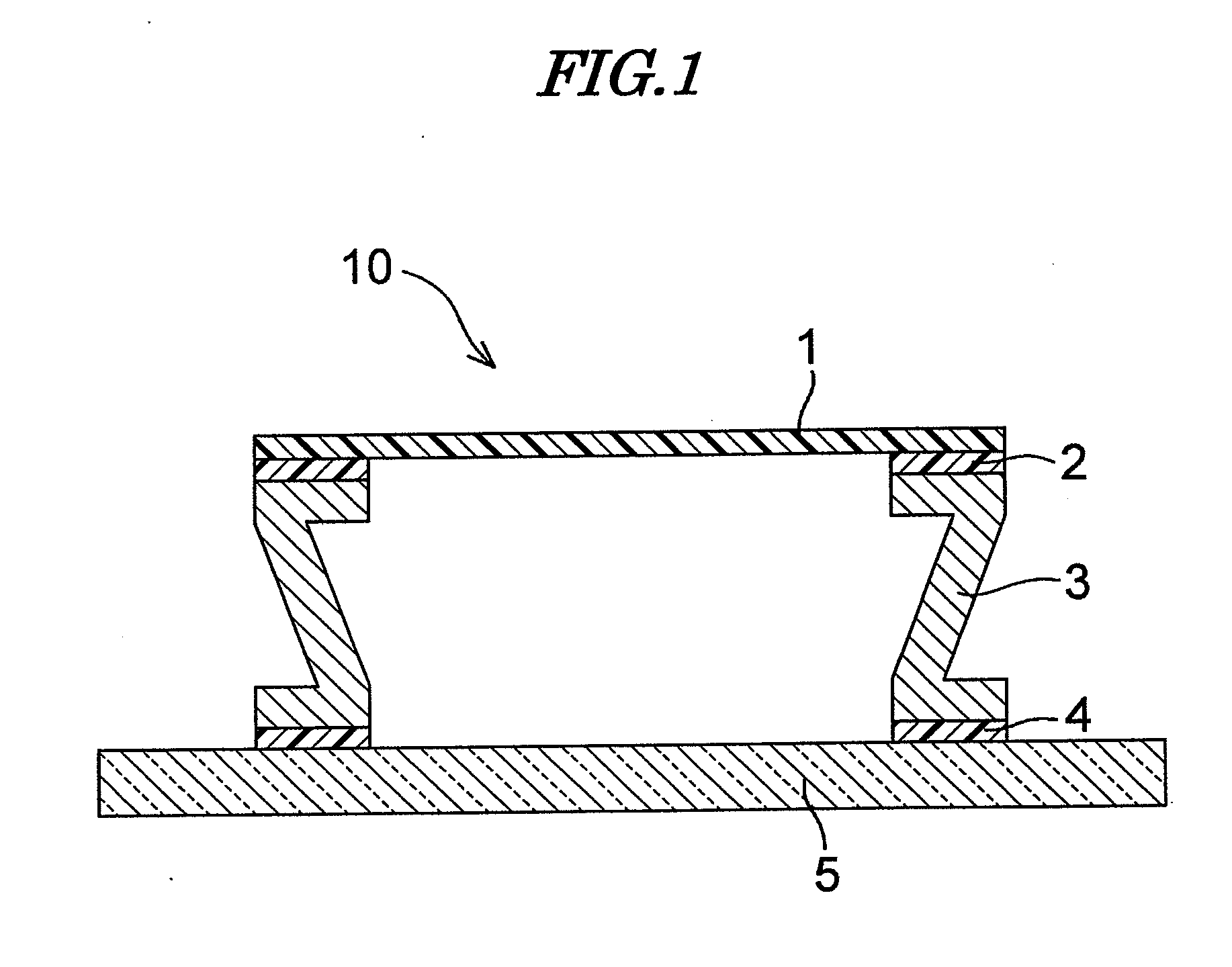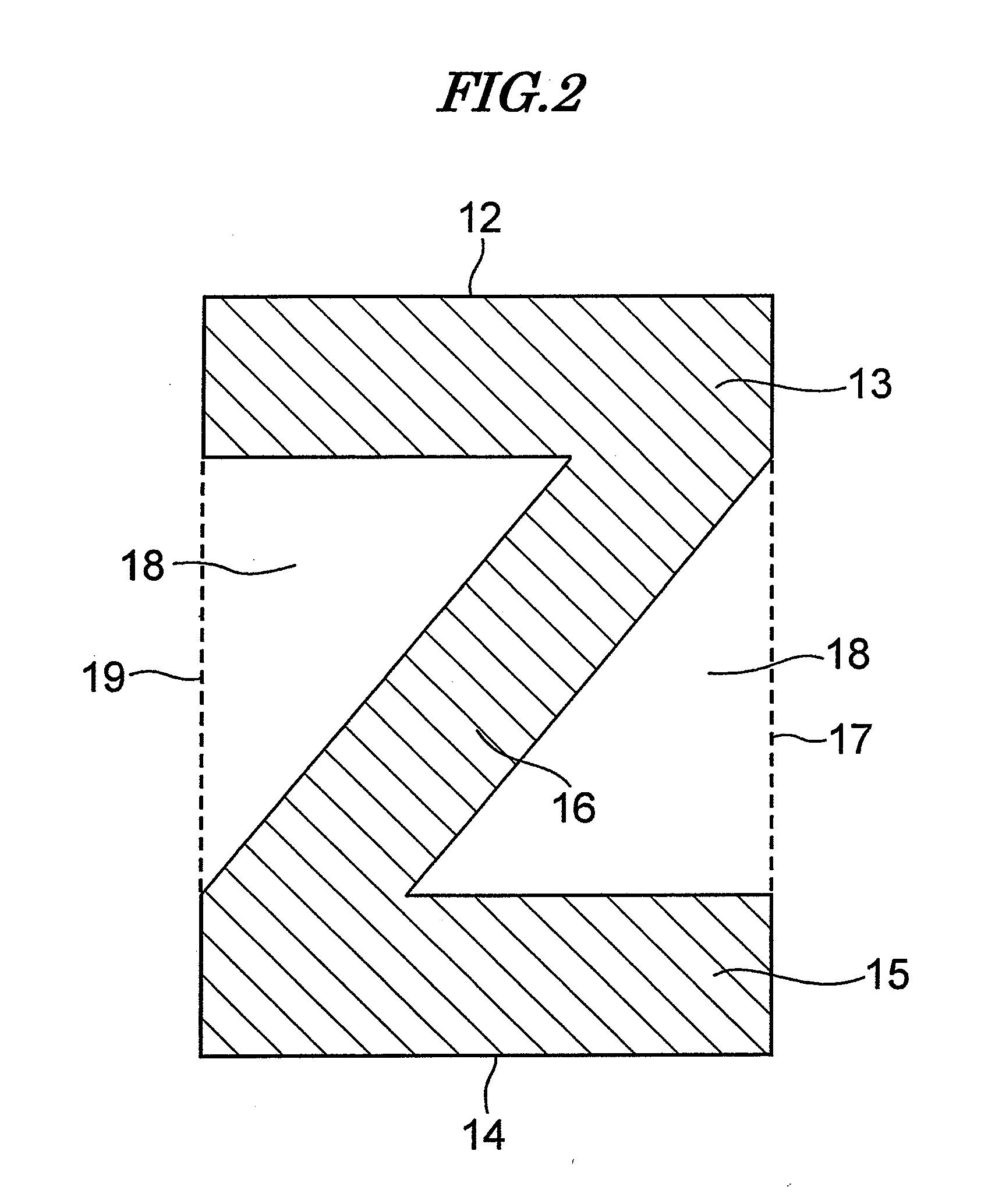Pellicle frame and lithographic pellicle
a lithographic and pellicle technology, applied in the field of lithographic pellicle and lithographic pellicle, can solve the problems of deformation of the repeating pattern, impairing the quality, appearance, and difficulty in always keeping the exposure master plate clean, and achieve the effect of suppressing the deformation of the exposure master pla
- Summary
- Abstract
- Description
- Claims
- Application Information
AI Technical Summary
Benefits of technology
Problems solved by technology
Method used
Image
Examples
example 1
[0093]A pellicle frame with outer dimensions of 149 mm×122 mm×3.5 mm and a width of the upper edge and lower edge of 2 mm was prepared from an aluminum alloy (the cross-sectional shape being shown in FIG. 4 (a), and the cross-sectional area being 3.25 mm2). The cross-sectional shape was a Z shape obtained by removing right-angled triangles having a height of 2.5 mm and a width of an upper edge (lower edge) of 1.5 mm from opposite side faces of a rectangle having a height of 3.5 mm and a width of 2.0 mm in a staggered manner on opposite sides of a central part. The thickness of the upper end part and lower end part was 0.5 mm, and the width in the horizontal direction of the middle part was also 0.5 mm. Four corners of the pellicle frame were subjected to C-chamfering.
[0094]When the flatness of this frame was measured from the side that was to be coated with a mask pressure-sensitive adhesive, it was found to be 20 μm. One end face of the frame was coated with the mask pressure-sensi...
example 2
[0099]A pellicle frame having the same cross-sectional shape as Example 1 with outer dimensions of 149 mm×122 mm×3.5 mm and a width of the upper edge and lower edge of 2 mm was prepared from a magnesium alloy (the cross-sectional shape being shown in FIG. 4 (a), and the cross-sectional area being 3.25 mm2). When the flatness of this frame was measured from the side that was to be coated with a mask pressure-sensitive adhesive, it was found to be 20 μm. One end face of the frame was coated with the mask pressure-sensitive adhesive, and the other end face was coated with a film adhesive. Subsequently, the pellicle film previously peeled off was affixed to the film adhesive side of the magnesium alloy frame and the film on the outer periphery of the frame was cut, thus completing a pellicle.
[0100]The pellicle thus completed was affixed to a 142 mm square mask with a flatness of 0.25 μm using a load of 20 kg. Subsequently, when the flatness of the pellicle-equipped mask was measured aga...
example 3
[0101]A pellicle frame having the same cross-sectional shape as Example 1 with outer dimensions of 149 mm×122 mm×3.5 mm and a width of the upper edge and lower edge of 2 mm was prepared from a polycarbonate resin (the cross-sectional shape being shown in FIG. 4 (a), and the cross-sectional area being 3.25 mm2). When the flatness of this frame was measured from the side that was to be coated with a mask pressure-sensitive adhesive, it was found to be 20 μm. One end face of the frame was coated with the mask pressure-sensitive adhesive, and the other end face was coated with a film adhesive. Subsequently, the pellicle film previously peeled off was affixed to the film adhesive side of the polycarbonate resin frame and the film on the outer periphery of the frame was cut, thus completing a pellicle.
[0102]The pellicle thus completed was affixed to a 142 mm square mask with a flatness of 0.25 μm using a load of 20 kg. Subsequently, when the flatness of the pellicle-equipped mask was meas...
PUM
 Login to View More
Login to View More Abstract
Description
Claims
Application Information
 Login to View More
Login to View More - R&D
- Intellectual Property
- Life Sciences
- Materials
- Tech Scout
- Unparalleled Data Quality
- Higher Quality Content
- 60% Fewer Hallucinations
Browse by: Latest US Patents, China's latest patents, Technical Efficacy Thesaurus, Application Domain, Technology Topic, Popular Technical Reports.
© 2025 PatSnap. All rights reserved.Legal|Privacy policy|Modern Slavery Act Transparency Statement|Sitemap|About US| Contact US: help@patsnap.com



